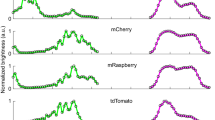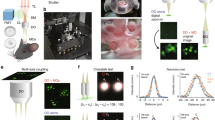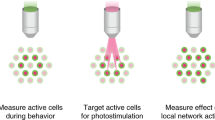Abstract
Imaging of 300–500 μm mouse brain slices by laser photostimulation with flavoprotein autofluorescence (LFPA) allows the rapid and sensitive mapping of neuronal connectivity. It is accomplished using UV laser-based photo-uncaging of glutamate and imaging neuronal activation by capturing changes in green light (∼520 nm) emitted under blue light (∼460 nm) excitation. This fluorescence is generated by the oxidized form of flavoprotein and is a measure of metabolic activity. LPFA offers several advantages over imaging techniques that rely on dye loading. First, as flavoprotein imaging measures endogenous signals, it avoids the use of heterogeneously loaded and potentially cytotoxic dyes. Second, flavoprotein signals are large (1–20% above baseline), obviating the need for averaging. Third, the use of photostimulation ensures orthodromic neuronal activation and permits the rapid interrogation of multiple stimulation sites of the slice with a high degree of precision (∼50 μm). Here we describe a step-by-step protocol for the incorporation of LPFA into virtually any slice rig, as well as how to do the experiment.
This is a preview of subscription content, access via your institution
Access options
Subscribe to this journal
Receive 12 print issues and online access
$259.00 per year
only $21.58 per issue
Buy this article
- Purchase on Springer Link
- Instant access to full article PDF
Prices may be subject to local taxes which are calculated during checkout




Similar content being viewed by others
References
Obaid, A.L., Koyano, T., Lindstrom, J., Sakai, T. & Salzberg, B.M. Spatiotemporal patterns of activity in an intact mammalian network with single-cell resolution: optical studies of nicotinic activity in an enteric plexus. J. Neurosci. 19, 3073–3093 (1999).
Onimaru, H. & Homma, I. A novel functional neuron group for respiratory rhythm generation in the ventral medulla. J. Neurosci. 23, 1478–1486 (2003).
Fields, R.D., Shneider, N., Mentis, G.Z. & O'Donovan, M.J. Imaging Nervous System Activity (John Wiley & Sons, 2001).
Petrof, I. & Sherman, S.M. Synaptic properties of the mammillary and cortical afferents to the anterodorsal thalamic nucleus in the mouse. J. Neurosci. 29, 7815–7819 (2009).
Llano, D.A., Theyel, B.B., Mallik, A.K., Sherman, S.M. & Issa, N.P. Rapid and sensitive mapping of long-range connections in vitro using flavoprotein autofluorescence imaging combined with laser photostimulation. J. Neurophysiol. 101, 3325–3340 (2009).
Shibuki, K. et al. Dynamic imaging of somatosensory cortical activity in the rat visualized by flavoprotein autofluorescence. J. Physiol. 549, 919–927 (2003).
Theyel, B.B., Llano, D.A. & Sherman, S.M. The corticothalamocortical circuit drives higher-order cortex in the mouse. Nat. Neurosci. 13, 84–88 (2010).
Reinert, K.C., Dunbar, R.L., Gao, W., Chen, G. & Ebner, T.J. Flavoprotein autofluorescence imaging of neuronal activation in the cerebellar cortex in vivo. J. Neurophysiol. 92, 199–211 (2004).
Reinert, K.C., Gao, W., Chen, G. & Ebner, T.J. Flavoprotein autofluorescence imaging in the cerebellar cortex in vivo. J. Neurosci. Res. 85, 3221–3232 (2007).
Katz, L. & Dalva, M. Scanning laser photostimulation: a new approach for analyzing brain circuits. J. Neurosci. Methods 54, 205–218 (1994).
Shibuki, K., Hishida, R., Kitaura, H., Takahashi, K. & Tohmi, M. Coupling of brain function and metabolism: endogenous flavoprotein fluorescence imaging of neural activities by local changes in energy metabolism. in Handbook of Neurochemistry and Molecular Neurobiology Ch. 4.4, 321–342 (Springer, 2007).
Briggs, F. & Callaway, E.M. Laminar patterns of local excitatory input to layer 5 neurons in macaque primary visual cortex. Cerebral Cortex 15, 479–488 (2005).
Husson, T.R., Mallik, A.K., Zhang, J.X. & Issa, N.P. Functional imaging of primary visual cortex using flavoprotein autofluorescence. J. Neurosci. 27, 8665–8675 (2007).
Molnar, P. & Nadler, J.V. Mossy fiber-granule cell synapses in the normal and epileptic rat dentate gyrus studied with minimal laser photostimulation. J. Neurophysiol. 82, 1883–1894 (1999).
Reinert, K.C., Gao, W., Chen, G. & Ebner, T.J. Flavoprotein autofluorescence imaging in the cerebellar cortex in vivo. J. Neurosci. Res. 85, 3221–3232 (2007).
Theyel, B.B., Kohrman, M.H., Frim, D.M. & van Drongelen, W. Network variability across human tissue samples in vitro: the problem and a solution. J. Clin. Neurophysiol. 27, 412–417 (2010).
Logothetis, N.K. & Wandell, B.A. Interpreting the BOLD signal. Annu. Rev. Physiol. 66, 735–769 (2004).
Gaspers, L.D. & Thomas, A.P. Calcium-dependent activation of mitochondrial metabolism in mammalian cells. Methods 46, 224–232 (2008).
Huang, S., Heikal, A.A. & Webb, W.W. Two-photon fluorescence spectroscopy and microscopy of NAD(P)H and flavoprotein. Biophys. J. 82, 2811–2825 (2002).
Shepherd, G.M.G., Pologruto, T.A. & Svoboda, K. Circuit analysis of experience-dependent plasticity in the developing rat barrel cortex. Neuron 38, 277–289 (2003).
Cohen, P.J. Effect of anesthetics on mitochondrial function. Anesthesiology 39, 153–164 (1973).
Agmon, A. & Connors, B.W. Thalamocortical responses of mouse somatosensory (barrel) cortexin vitro. Neuroscience 41, 365–379 (1991).
Author information
Authors and Affiliations
Contributions
B.B.T. and D.A.L. generated data shown in the figures. B.B.T. generated a draft of the manuscript. All authors contributed to editing the manuscript and development of laser-scanning photostimulation.
Corresponding author
Ethics declarations
Competing interests
The authors declare no competing financial interests.
Supplementary information
Supplementary Method 1
Text file for "imageproc_streampix" (TXT 1 kb)
Supplementary Method 2
Text file for "imageproc_laser" (TXT 2 kb)
Supplementary Method 3
Text file for "march" (TXT 1 kb)
Supplementary Method 4
Text file for "deltamarch" (TXT 1 kb)
Supplementary Method 5
Zip file containing the programs as Matlab files (ZIP 3 kb)
Rights and permissions
About this article
Cite this article
Theyel, B., Llano, D., Issa, N. et al. In vitro imaging using laser photostimulation with flavoprotein autofluorescence. Nat Protoc 6, 502–508 (2011). https://doi.org/10.1038/nprot.2011.315
Published:
Issue Date:
DOI: https://doi.org/10.1038/nprot.2011.315
This article is cited by
-
Functional Convergence of Thalamic and Intrinsic Projections to Cortical Layers 4 and 6
Neurophysiology (2013)
Comments
By submitting a comment you agree to abide by our Terms and Community Guidelines. If you find something abusive or that does not comply with our terms or guidelines please flag it as inappropriate.



